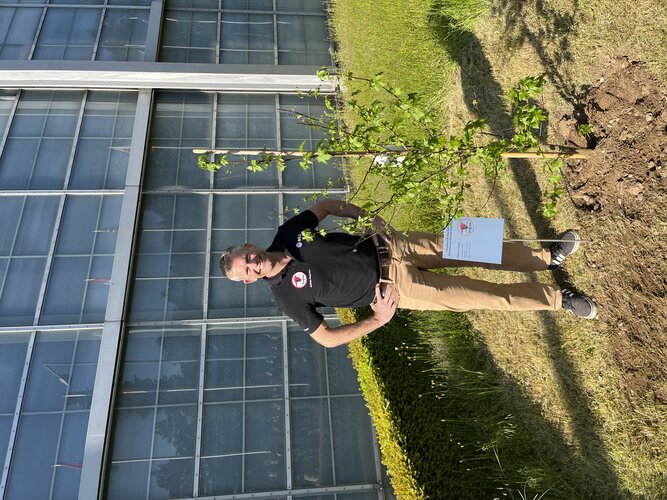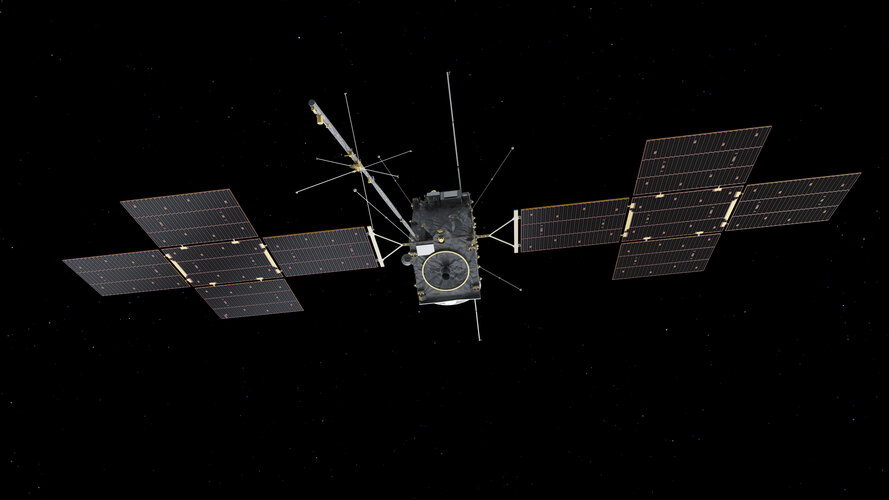
Copernical Team
Friday, 26 May 2023 12:54
Tree planting for the Huginn mission
 Image:
Tree planting for the Huginn mission
Image:
Tree planting for the Huginn mission
Published in
News
Tagged under
Friday, 26 May 2023 11:22
Week in images: 22-26 May 2023

Week in images: 22-26 May 2023
Discover our week through the lens
Published in
News
Tagged under
Friday, 26 May 2023 13:29
Juice deployments complete: final form for Jupiter

Flight controllers at ESA’s mission control centre in Germany have been busy this week, working with instrument teams on the final deployments to prepare ESA’s Jupiter Icy Moons Explorer (Juice) for exploring Jupiter.
Published in
News
Tagged under
Friday, 26 May 2023 07:00
Earth from Space: São Paulo, Brazil
 Image:
This radar image from Copernicus Sentinel-1 shows the city of São Paulo and part of the homonymous state in southeast Brazil.
Image:
This radar image from Copernicus Sentinel-1 shows the city of São Paulo and part of the homonymous state in southeast Brazil.
Published in
News
Tagged under
Friday, 26 May 2023 09:56
NASA funds small business to advance tech for Space, Earth
Washington DC (SPX) May 24, 2023
 A new slate of funding from NASA will help small businesses develop technologies to advance space exploration, climate research, and more. In mid-April, NASA selected 112 proposals from 92 U.S. small businesses across 28 states to receive Phase II funding from the Small Business Innovation Research (SBIR) program, totaling approximately $98 million.
This program provides early-stage fundin
A new slate of funding from NASA will help small businesses develop technologies to advance space exploration, climate research, and more. In mid-April, NASA selected 112 proposals from 92 U.S. small businesses across 28 states to receive Phase II funding from the Small Business Innovation Research (SBIR) program, totaling approximately $98 million.
This program provides early-stage fundin
 A new slate of funding from NASA will help small businesses develop technologies to advance space exploration, climate research, and more. In mid-April, NASA selected 112 proposals from 92 U.S. small businesses across 28 states to receive Phase II funding from the Small Business Innovation Research (SBIR) program, totaling approximately $98 million.
This program provides early-stage fundin
A new slate of funding from NASA will help small businesses develop technologies to advance space exploration, climate research, and more. In mid-April, NASA selected 112 proposals from 92 U.S. small businesses across 28 states to receive Phase II funding from the Small Business Innovation Research (SBIR) program, totaling approximately $98 million.
This program provides early-stage fundin
Published in
News
Tagged under
Friday, 26 May 2023 09:56
Powerful Arab League communications satellite ready for night launch
Cape Canaveral FL (SPX) May 24, 2023
 A powerful communication relay satellite for the 21-member Arab League is scheduled for launch Tuesday from Cape Canaveral Space Force Station in Florida. weather permitting.
SpaceX plans to carry ARABSAT BADR-8 satellite into a geosynchronous transfer orbit aboard a Falcon 9 rocket from Launch Complex 40, with a 127-minute window that opens at 11:25 p.m. EDT.
However, forecasters ha
A powerful communication relay satellite for the 21-member Arab League is scheduled for launch Tuesday from Cape Canaveral Space Force Station in Florida. weather permitting.
SpaceX plans to carry ARABSAT BADR-8 satellite into a geosynchronous transfer orbit aboard a Falcon 9 rocket from Launch Complex 40, with a 127-minute window that opens at 11:25 p.m. EDT.
However, forecasters ha
 A powerful communication relay satellite for the 21-member Arab League is scheduled for launch Tuesday from Cape Canaveral Space Force Station in Florida. weather permitting.
SpaceX plans to carry ARABSAT BADR-8 satellite into a geosynchronous transfer orbit aboard a Falcon 9 rocket from Launch Complex 40, with a 127-minute window that opens at 11:25 p.m. EDT.
However, forecasters ha
A powerful communication relay satellite for the 21-member Arab League is scheduled for launch Tuesday from Cape Canaveral Space Force Station in Florida. weather permitting.
SpaceX plans to carry ARABSAT BADR-8 satellite into a geosynchronous transfer orbit aboard a Falcon 9 rocket from Launch Complex 40, with a 127-minute window that opens at 11:25 p.m. EDT.
However, forecasters ha
Published in
News
Tagged under
Friday, 26 May 2023 09:56
Mainland, Macao put 2 satellites into orbit
Beijing (XNA) May 24, 2023
 China launched two science satellites on Sunday afternoon jointly developed by scientists from the mainland and Macao, according to the China National Space Administration.
The Macao Science Satellite 1A and 1B were carried by a Long March 2C carrier rocket that lifted off at 4 pm from the Jiuquan Satellite Launch Center in northwestern China's Gobi Desert.
The launch marks the 474th
China launched two science satellites on Sunday afternoon jointly developed by scientists from the mainland and Macao, according to the China National Space Administration.
The Macao Science Satellite 1A and 1B were carried by a Long March 2C carrier rocket that lifted off at 4 pm from the Jiuquan Satellite Launch Center in northwestern China's Gobi Desert.
The launch marks the 474th
 China launched two science satellites on Sunday afternoon jointly developed by scientists from the mainland and Macao, according to the China National Space Administration.
The Macao Science Satellite 1A and 1B were carried by a Long March 2C carrier rocket that lifted off at 4 pm from the Jiuquan Satellite Launch Center in northwestern China's Gobi Desert.
The launch marks the 474th
China launched two science satellites on Sunday afternoon jointly developed by scientists from the mainland and Macao, according to the China National Space Administration.
The Macao Science Satellite 1A and 1B were carried by a Long March 2C carrier rocket that lifted off at 4 pm from the Jiuquan Satellite Launch Center in northwestern China's Gobi Desert.
The launch marks the 474th
Published in
News
Tagged under
Friday, 26 May 2023 09:56
Gogo elevates its global broadband offering with second, higher throughput antenna
Geneva, Switzerland (SPX) May 24, 2023
 Gogo Business Aviation (NASDAQ: GOGO) has announced its Gogo Galileo product line with the unveiling of a second electronically steered antenna (ESA) form factor for use on its Low Earth Orbit (LEO) broadband solution.
Gogo Galileo now offers two fuselage-mount antennas - the previously announced "HDX" antenna, designed with a small form factor to fit on any size business aircraft, and tod
Gogo Business Aviation (NASDAQ: GOGO) has announced its Gogo Galileo product line with the unveiling of a second electronically steered antenna (ESA) form factor for use on its Low Earth Orbit (LEO) broadband solution.
Gogo Galileo now offers two fuselage-mount antennas - the previously announced "HDX" antenna, designed with a small form factor to fit on any size business aircraft, and tod
 Gogo Business Aviation (NASDAQ: GOGO) has announced its Gogo Galileo product line with the unveiling of a second electronically steered antenna (ESA) form factor for use on its Low Earth Orbit (LEO) broadband solution.
Gogo Galileo now offers two fuselage-mount antennas - the previously announced "HDX" antenna, designed with a small form factor to fit on any size business aircraft, and tod
Gogo Business Aviation (NASDAQ: GOGO) has announced its Gogo Galileo product line with the unveiling of a second electronically steered antenna (ESA) form factor for use on its Low Earth Orbit (LEO) broadband solution.
Gogo Galileo now offers two fuselage-mount antennas - the previously announced "HDX" antenna, designed with a small form factor to fit on any size business aircraft, and tod
Published in
News
Tagged under
Friday, 26 May 2023 09:56
Inmarsat's expands inflight broadband plans for business aviation customers
London, UK (SPX) May 24, 2023
 Inmarsat has announced the next chapter of its market-leading Jet ConneX (JX) inflight broadband solution, with a new range of service plans introduced to redefine gold standard connectivity in the business aviation market and satisfy even the most data-hungry users for many years to come.
Launched as part of Inmarsat's JX Evolution programme, these latest service plans are available for n
Inmarsat has announced the next chapter of its market-leading Jet ConneX (JX) inflight broadband solution, with a new range of service plans introduced to redefine gold standard connectivity in the business aviation market and satisfy even the most data-hungry users for many years to come.
Launched as part of Inmarsat's JX Evolution programme, these latest service plans are available for n
 Inmarsat has announced the next chapter of its market-leading Jet ConneX (JX) inflight broadband solution, with a new range of service plans introduced to redefine gold standard connectivity in the business aviation market and satisfy even the most data-hungry users for many years to come.
Launched as part of Inmarsat's JX Evolution programme, these latest service plans are available for n
Inmarsat has announced the next chapter of its market-leading Jet ConneX (JX) inflight broadband solution, with a new range of service plans introduced to redefine gold standard connectivity in the business aviation market and satisfy even the most data-hungry users for many years to come.
Launched as part of Inmarsat's JX Evolution programme, these latest service plans are available for n
Published in
News
Tagged under
Friday, 26 May 2023 09:56
NASA's Hubble hunts for intermediate-sized black hole close to home
Baltimore MD (SPX) May 24, 2023
 Astronomers using NASA's Hubble Space Telescope have come up with what they say is some of their best evidence yet for the presence of a rare class of "intermediate-sized" black hole that may be lurking in the heart of the closest globular star cluster to Earth, located 6,000 light-years away.
Like intense gravitational potholes in the fabric of space, virtually all black holes seem to com
Astronomers using NASA's Hubble Space Telescope have come up with what they say is some of their best evidence yet for the presence of a rare class of "intermediate-sized" black hole that may be lurking in the heart of the closest globular star cluster to Earth, located 6,000 light-years away.
Like intense gravitational potholes in the fabric of space, virtually all black holes seem to com
 Astronomers using NASA's Hubble Space Telescope have come up with what they say is some of their best evidence yet for the presence of a rare class of "intermediate-sized" black hole that may be lurking in the heart of the closest globular star cluster to Earth, located 6,000 light-years away.
Like intense gravitational potholes in the fabric of space, virtually all black holes seem to com
Astronomers using NASA's Hubble Space Telescope have come up with what they say is some of their best evidence yet for the presence of a rare class of "intermediate-sized" black hole that may be lurking in the heart of the closest globular star cluster to Earth, located 6,000 light-years away.
Like intense gravitational potholes in the fabric of space, virtually all black holes seem to com
Published in
News
Tagged under

